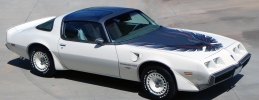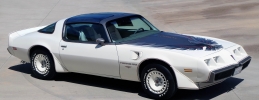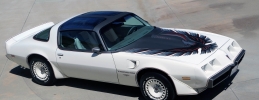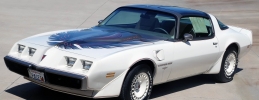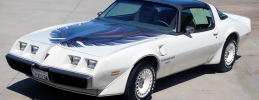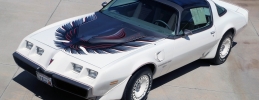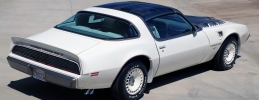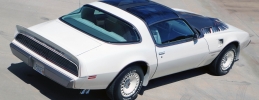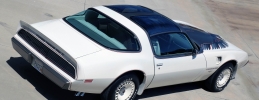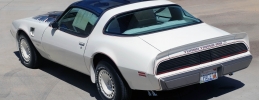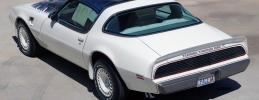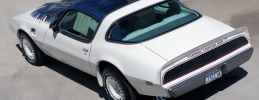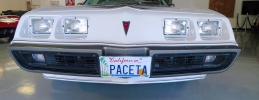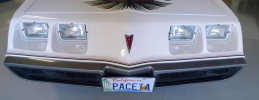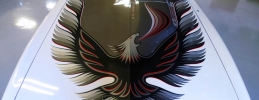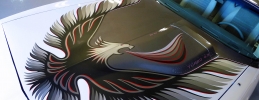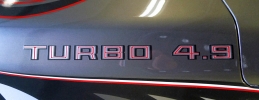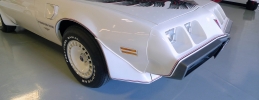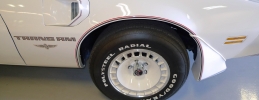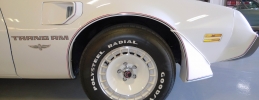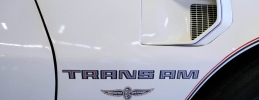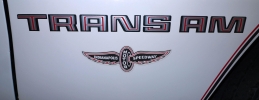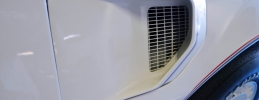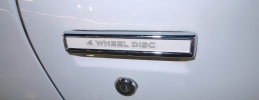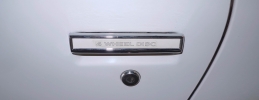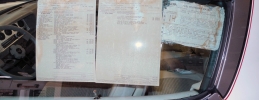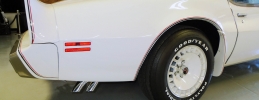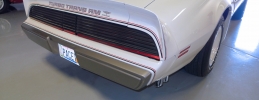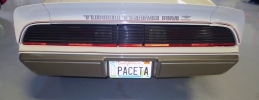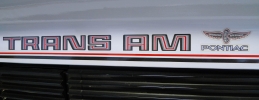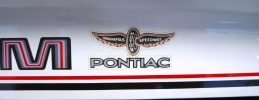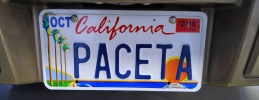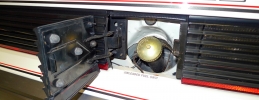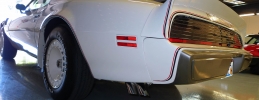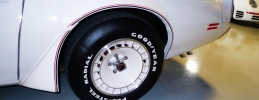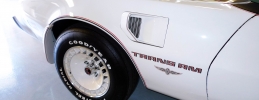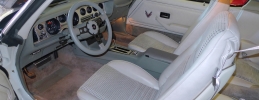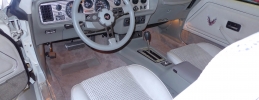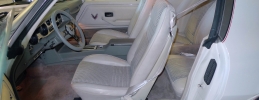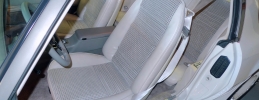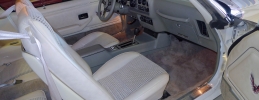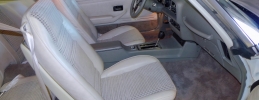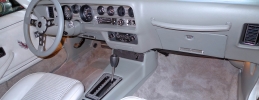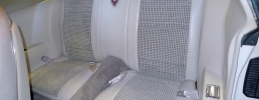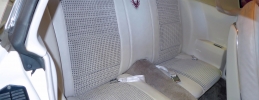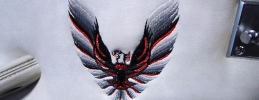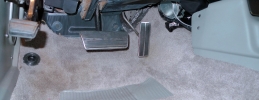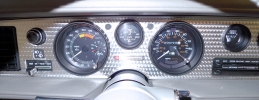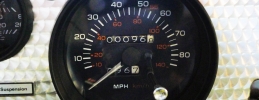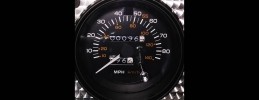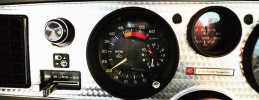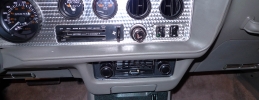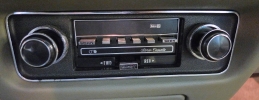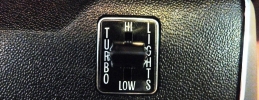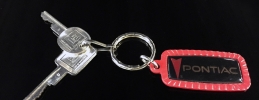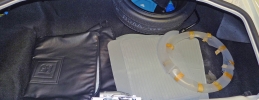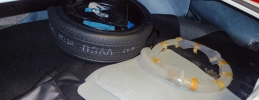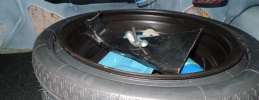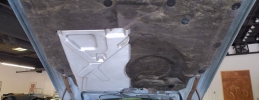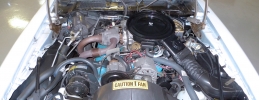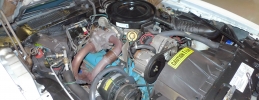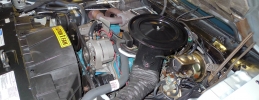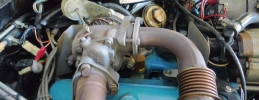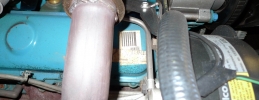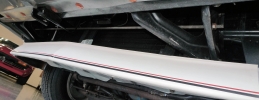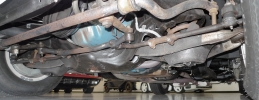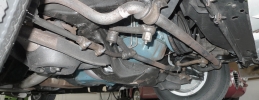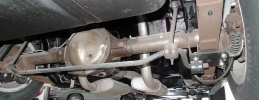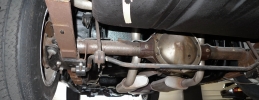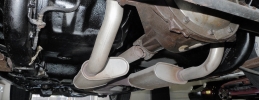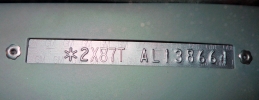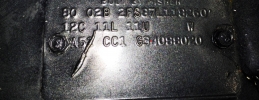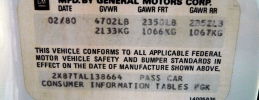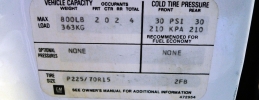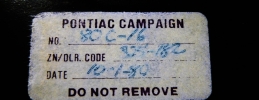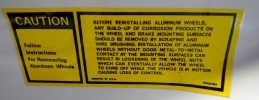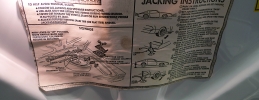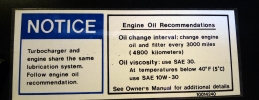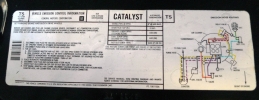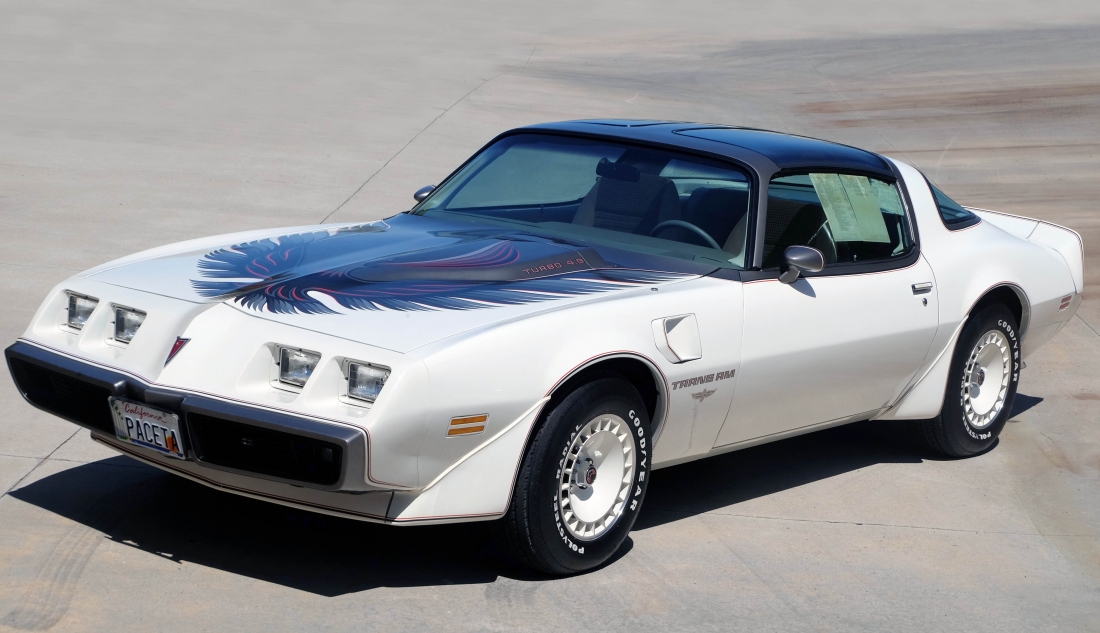
1980 Pontiac Turbo Trans Am Pace Car
Chassis No. 2x87T ALI38664
Vehicle Specifications
| Stock No.: | |
| Year: | 1980 |
| Make: | Pontiac |
| Model: | Turbo Trans Am Firebird |
| Chassis No.: | 2X87T ALI38664 |
| Engine No.: | |
| Exterior Color: | white |
| Interior Color: | gray |
| Mileage | 96 |
Having watched first the Ford Mustang and then the Chevrolet Camaro enter into the pony car market, Pontiac finally got into the act in the middle of 1967. The Firebird was offered with both six and eight cylinder engines, like the Mustang and Camaro, and was based heavily on the Chevrolet Camaro chassis. Pontiac did try to make it their own and would create a European styled and mannered pony car that could hold its own against its more experienced competition. The Pontiac Firebird was released five months after the Chevrolet Camaro, and offered buyers choices of six and eight cylinder engines. Pontiac was able to use that additional time to create a unique identity for the Firebird, despite having to use the Camaro chassis and some body panels. Despite using the same front fenders, doors, and rear fenders as the Camaro, the Firebird’s styled split front grille, beaked hood, and GTO-slitted taillights gave it a distinctly Pontiac apperance. But the key differentiator was under the hood, where the Firebird offered a range of Pontiac engines. Initially, five different Firebirds were available, named after their respective engine choices. These were a combination of both economy and performance six-cylinder engines and performance oriented V8s.
1969:
The Pontiac Firebird underwent a major restyling for the 1969 model year. The front end was redone and the rear end and interior were changed slightly. The redesign did not do well with customers, and sales fell, despite the fact that production lasted for 17 months, well into 1970 due to production problems with the 1970 model. Both 6 and 8-cylinder engines were once again offered but something altogether new was in store for the more sporting buyer.
Trans Am:
In March of 1969, Pontiac released a little publicized option package, the Trans Am Performance and Appearance Package. Conceived to campaign in the SCCA’s road racing series (with a special 303 cubic inch V8 which was never offered in production cars), Pontiac paid a $5 license fee to SCCA for each Trans Am sold to use the name. Offered as a $725 option, only 689 Firebird coupes and 8 convertibles (talk about a collectible) were built. Although not appearent at the time, the Pontiac Firebird Trans Am, along with the Chevrolet Corvette, would be the only American high performance cars that would remain in continuous production since their inception.
Second Generation Trans AMs:
An all new Pontiac Firebird was introduced for 1970 and represented a new high for Pontiac styling. The front bumper and grille were molded out of Endura rubber and were painted the same color as the car to give it a bumperless appearance. The sides sported rounded full wheel cut outs without any extra trim (the Camaro had more squared off wheel cut outs). The suspension was revised and a rear stabilizer bar was added. The Firebird lineup was reduced from six to four, and the convertible was eliminated. At the bottom of the line up was the Base Firebird, whose Pontiac 250 I6 was replaced by a Chevy built 250 I6 rated at a meager 155bhp and at the top was the all new Trans Am which was fitted with air dams across the bottom of the front and in front of the wheels. A large decklid spoiler and small spoilers in front of the rear wheels completed the package. These aero pieces were claimed to generate 50 pounds of downforce on the front and rear of the car at highway speeds. Trans Ams also received a rear facing shaker hood scope to feed the standard Ram Air II engine. Optional on the Trans Am was the Ram Air IV engine, whose output had increased to 370 bhp due to bigger ports, better heads, swirl-polished valves, and an aluminum instake manifold.
1980 Turbo Trans AM:
As the 1970s drew to a close, the 1979 and 1980 Pontiac Firebird received a new nose, with the four rectangular headlights all in their own bezels, and the split grille was moved below them. The rear end featured blackout panels disguising the taillights on Formula and Trans Am models. All models also received some revised graphics. In 1980, Pontiac dropped its 400 V8 and installed a new Turbo-charged 301 (4.9 liter) V8 as its top engine choice. The Turbo 4.9 was rated at 210 bhp. There was no Turbo boost indicator but instead three sequential “boost” lights built into the rear facing edge, just ahead of the driver on the front bonnet. That year a rare special edition version Pontiac Trans Am was selected as the pace car for the Indianapolis 500 race. In 1980, Pontiac built 50,896 Trans Ams but of those just 5,700 Pontiac Special Edition Turbo Trans Am Indy 500 Pace Cars were completed and sold to the public.
“*2X87T AL138664*”
In early February of 1980, one very fortunate, Special Edition Turbo Trans Am Indy 500 Pace Car was completed. Unlike the other 5,699 examples built, this particular Trans Am was purchased and set aside for display in a private museum where it would remain its entire life. this Trans Am was well cared for and ultra-carefully preserved but un-driven for the next 36 years until finally surfacing publicly for the first time and being purchased with just 96 original miles by our company.
This particular Trans Am was ordered new by Hoover Pontiac-Cadillac, Inc., in Olympia, Washington. The vehicle was assembled in the Van Nuys, California plant beginning in in the last week of January 1980 and being finished on February 1st, 1980. On February 18th of that year, a new certificate of origin for a motor vehicle was issued by Pontiac Motor Division, General Motors Corporation and sent to Hoover Pontiac-Cadillac in advance of the delivery of the vehicle itself. Actual shipping and possession of this particular Trans Am by Hoover was delayed until October 1st of 1980.
The original Pontiac Assembly Records provide a wealth of detailed information on the assembly and specifications of this particular Trans Am. It was equipped and configured as follows:
-Cameo White Upper and Lower Paint
-Oyster Grey Deluxe Interior
-LU8 4.9-liter, 301 cubic-inch, 4BBL Turbo V-8 Engine
-Automatic Transmission
-Limited Slip Differential
-Custom Air Conditioning System
-Heavy Duty 70 Amp Alternator
-Heavy Duty Battery
-Custom Seat Belts (Front and Rear)
-Cruise Control
-Remote Control Rear Deck-Lid Release
-Rear Window Defroster
-Rally Clock
-Special Tach Gauge Cluster Assembly
-Front Bonnet Mounted Turbo Boost Lights
-Tinted Windows on all Windows
-Door Edge Guards
-Tungsten Quartz Halogen Headlamps
-Full Acoustical Insulation Package
-Special Lamp Package (Luggage Compartment, Gove Box, Couresy Panels)
-Remote Control Sport Mirrors (Left and Right)
-Automatic Radio Power Antenna
-Power Windows
-Space Saver Spare Tire
-Special Performance Package that included:
—225/70R15 White-Letter Goodyear Radial Tires
—Power Brakes
—Front and Rear Disc Brakes
—Special Handling Package
—Turbo-Cast, 8-Inch Alloy Wheels
-Rear Deck-Lid Spoiler
-Tilt Steering Wheel
-Alloy Wheel Covers in White
-Multi-Speed Windshield Wipers
-Special Edition Trans Am Option Package that included:
—Removable T-Top Roof Panels with Silver Trim
—Turbo Bird Hood Decal
—Special Interior Trim
—Red Dash Display Lighting
—Special Limited Edition Decals
—Leather Wrapped Steering Wheel
—Special Turned Metal Dash
—Special White Paint with Charcoal Accents
-Custom Trim Group (Velour & Vinyl)
-Bucket Seats
-Custom Rear Seats
-Door Handle Ornamentation
-Pedal Trim Package
-Delco AM/FM Stereo Cassette Radio System
-Radio Power Amplifier Booster System
Including all of the above options and destination charges, this particular Trans Am’s window sticker showed a price of $11,894.52. Only a well equipped Corvette was more expensive that year.
Today, this Special Edition Trans Am remains absolutely as delivered new with a massive amount of the original Assembly Records and rare original delivery documents as well as a copy of the original Manufacturer’s Certificate of Origin. Make no mistake, this is more than just a museum piece. This vehicle has been ultra-carefully cared for, conserved and preserved in a fully operable state. All services are completely current with the air conditioning blowing ice-cold air, the radio fully functional and all accessories, lights, gauges and switches in as new, fully functional working order.
It was be absolutely impossible to fine a more carefully preserved, as new, un-used example anywhere in the world at any price. This would be an absolutely perfect vehicle for any museum collection but an even better candidate for the full show circuit. It would be a hands down favorite in the ever popular “Preservation Class” at any concours event world-wide.


